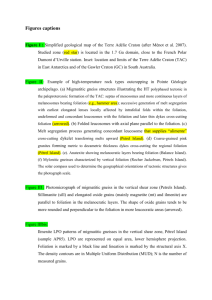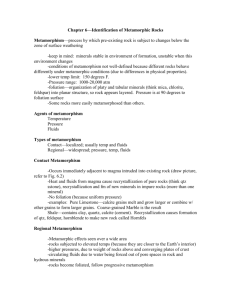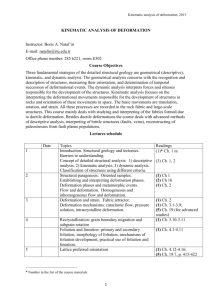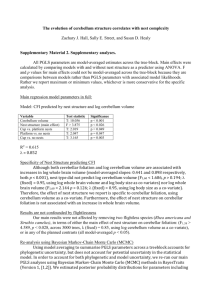Foliation
advertisement
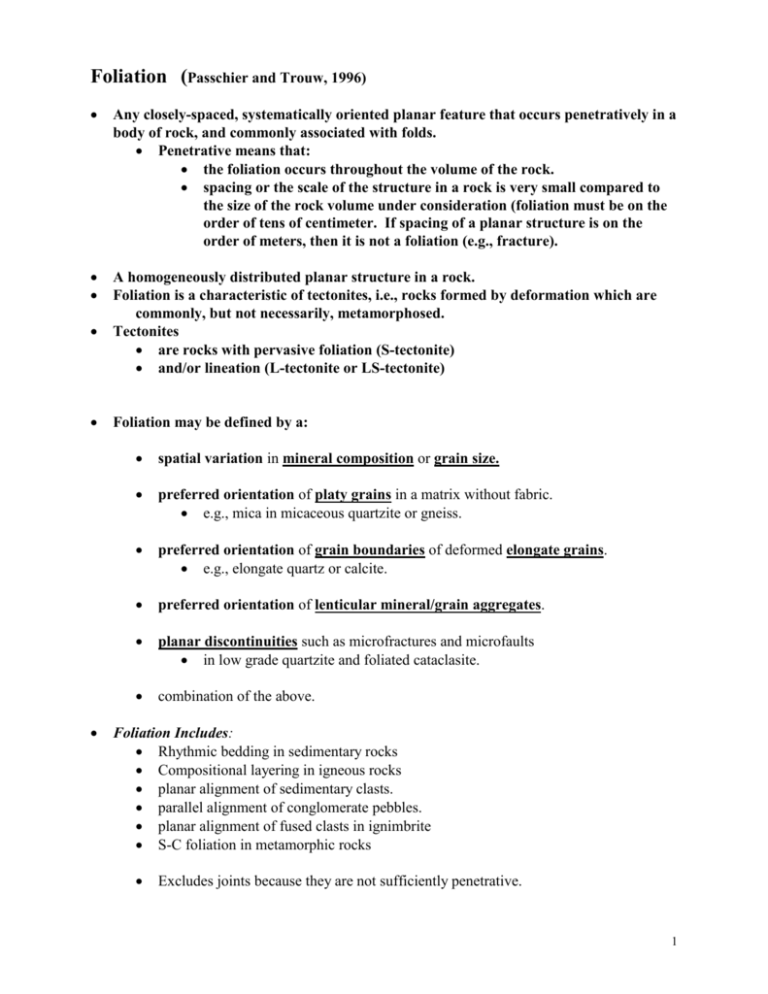
Foliation (Passchier and Trouw, 1996) Any closely-spaced, systematically oriented planar feature that occurs penetratively in a body of rock, and commonly associated with folds. Penetrative means that: the foliation occurs throughout the volume of the rock. spacing or the scale of the structure in a rock is very small compared to the size of the rock volume under consideration (foliation must be on the order of tens of centimeter. If spacing of a planar structure is on the order of meters, then it is not a foliation (e.g., fracture). A homogeneously distributed planar structure in a rock. Foliation is a characteristic of tectonites, i.e., rocks formed by deformation which are commonly, but not necessarily, metamorphosed. Tectonites are rocks with pervasive foliation (S-tectonite) and/or lineation (L-tectonite or LS-tectonite) Foliation may be defined by a: spatial variation in mineral composition or grain size. preferred orientation of platy grains in a matrix without fabric. e.g., mica in micaceous quartzite or gneiss. preferred orientation of grain boundaries of deformed elongate grains. e.g., elongate quartz or calcite. preferred orientation of lenticular mineral/grain aggregates. planar discontinuities such as microfractures and microfaults in low grade quartzite and foliated cataclasite. combination of the above. Foliation Includes: Rhythmic bedding in sedimentary rocks Compositional layering in igneous rocks planar alignment of sedimentary clasts. parallel alignment of conglomerate pebbles. planar alignment of fused clasts in ignimbrite S-C foliation in metamorphic rocks Excludes joints because they are not sufficiently penetrative. 1 Significance of Foliation 1. Deformed terranes commonly have several successive generations of foliation. If these can be distinguished from one another by type and age (cross-cutting relationships, absolute age dates, and overprinting under microscope), can help to unravel the tectonic and metamorphic evolution of an area. 2. Foliations can be used to as reference structures to establish the: relative growth periods of metamorphic minerals, especially porphyroblasts deformation phases in an area. Foliation may be related to folds, however, foliation is more penetrative than related folds and therefore can be seen better. 2 Primary Foliation Structures related to the original rock-forming process. Originated by sedimentary processes such as transport and deposition: Bedding (So) preferred orientation of sedimentary clasts Originated by primary igneous processes such as flow and crystallization: magmatic layering in igneous rocks preferred orientation of bubbles and pumice fragments Bedding results from discontinuous processes causing considerable variation in thickness, composition, texture, and structure of individual beds or layers. Bedding is easily recognized in gently deformed, very low grade metamorphic rocks from sedimentary features (texture and structure, fossils). Sedimentary structures can be used for facing (younging direction). Must be careful for the inversion of graded bedding by the growth of metamorphic minerals (e.g., large micas may grow in a metamorphosed originally fine pelitic rock. Original reverse grading is also common. Bedding is hard to recognize in more intense deformation and higher metamorphic grade. Is obliterated or disappeared by transposition and recrystallization. However, it only rarely may be parallel to the axial plane of folds. Recognition of primary foliation is important for the reconstruction of the structural evolution after sedimentation crystallization (So, S1, S2, etc). If bedding is not recognized, only the last part of the evolution can be reconstructed; the oldest compositional layering has to be labeled Sn, followed by Sn+1 , Sn+2. 3 Diagenetic Foliation Forms by diagenetic processes such as compaction in sediments with detrital mica (i.e., pelites). Are also known as bedding-parallel foliation. Observed in very low and low-grade pelitic sediments which have undergone little or no deformation. Is defined by parallel orientation of thin elongate detrital mica grains with frayed edges. The micas are commonly subparallel to bedding. The preferred orientation of the micas is due to their passive rotation. Diagenetic foliation is not associated with folds. It precedes the formation of secondary foliation. It plays an important role in development of secondary foliation in pelites. 4 Secondary Foliation Forms after lithification and crystallization of rocks. Forms by some kind of differentiation process in a stress field. Is commonly (sub)parallel to the fold axial plane. Is related to strain (parallel to the XY plane) and deformed features. Foliation forms perpendicular to the maximum shortening direction (Z). Forms as a result of: ductile deformation (by crystal plasticity or cataclastic flow) metamorphism. Includes: cleavage schistosity differentiated compositional layering mylonitic foliation (S and C). 5 Morphological Classification of Secondary Foliation (Powell, 1979; Borradaile, 1982; Passchier and Trouw, 1996) Secondary foliation shows a large variation of morphological features. The following descriptive classification scheme is independent of origin (non-genetic). It is based on the fabric elements that define the foliation such as: elongate or platy grains compositional layers or lenses planar discontinuities. Two general types of foliation: 1. Spaced foliation 2. Continuous foliation NOTES: Infinitely many transitional forms between foliation types may occur in nature. A foliation may change its morphology or even disappear in a single thin section Foliation development is strongly dependent on: lithotype strain 6 Spaced foliation: Fabric elements are not homogeneously distributed. The rock is divided into lenses or layers of different composition. Rock consists of two types of domains: 1. Cleavage domain: Planar, and have fabric elements subparallel to the trend of the domain. In metapelites, it is rich in mica and other minerals such as ilmenite, graphite, rutile, apatite, and zircon. 2. Microlithons lie between cleavage domains contain fabric elements with weak or no preferred orientation may contain fabric elements oblique to the cleavage domains. Spaced foliations are subdivided based on the structure in the microlithons. Crenulation cleavage: Microlithons contain microfolds of an earlier foliation. Disjunctive foliation: Microlithons have no microfolds. Called disjunctive cleavage is rock is fine-grained. Compositional layering: A special hype of spaced foliation where microlithons and cleavage domains are wide and continuous enough to form layers visible to the unaided eye in hand specimen. Morphological features used in the description of spaced foliation (Fig. 4.6). Spacing of the cleavage domains Shape of the cleavage domains rough, smooth, wriggly, stylolitic The % of cleavage domains in the rock The spatial relation between cleavage domains parallel, anastomosing, conjugate (two intersecting directions without any sign of overprinting) The transition from cleavage domains to microlithons gradational, discrete The shape of microfolds in crenulation cleavage symmetric, asymmetric 7 Continuous Foliation Fabric elements are homogeneously distributed, to the scale of grain individual minerals. Consists of a non-layered homogeneous distribution of platy mineral grains with a preferred orientation. minerals are commonly mica and amphibole; sometimes quartz, etc. The terminology is based on observation under the microscope. cleavage in slate under the microscope is continuous; it is spaced under SEM. Fabric elements such as grain shape and size are used to classify continuous foliations. Continuous Schistosity: grains defining the foliation are visible by the unaided eye. Continuous Cleavage or slaty cleavage: grains are finer and need microscope. Just like the distinction between mineral lineation and stretching lineation (linear shape fabric), continuous foliations are subdivided into: Mineral foliation: defined by the preferred orientation of platy but undeformed mineral grains such as micas or amphiboles. Planar shape fabrics: defined by flattened crystals such as quartz or calcite. 8 Likely Mechanisms of Secondary Foliation Development Factors controlling the development of foliation during deformation are: Rock composition Orientation and magnitude of stress Metamorphic conditions T, Plithostatic, Pfluid Fluid composition 1. 2. 3. 4. 5. 6. 7. Mechanical rotation of Tabular or elongate grains Solution transfer during pressure solution Crystal plastic deformation Dynamic recrystallization Mimetic growth Oriented growth defined by a stress field Microfolding 9 1. Foliation Formed by Mechanical Rotation of Tabular or Elongate Grains During homogenous ductile deformation A set of randomly oriented planes such as tabular or elongate grains with high aspect ratios (e.g., mica and amphiboles) will tend to rotate such that their mean orientation will trace the direction of the XY plane of the finite strain. If an earlier preferred orientation was present, the foliation will not trace the XY plane. 10 2. Foliation formed by Solution Transfer During Pressure Solution Pressure solution: Dissolution of grains at grain boundaries in a grain boundary fluid phase under high normal stress. Effective under presence of abundant fluid phase, and is therefore most active under diagenetic and low-grade metamorphic conditions. Solution transfer: Diffusion of dissolved material away from the sites of high solubility down a stress induced chemical potential gradient to nearby sites of low solubility. Pressure solution may lead to the formation of inequant grains defining a foliation. Pressure solution plays an important role in development of secondary foliation by microfolding (Fig. 4.17). Microfolding of an earlier foliation produces a difference in orientation of planar elements, such as mica and quartz contacts, with respect to the instantaneous 3, enhancing preferred dissolution in fold limbs, producing a differentiated crenulation cleavage and later a compositional layering. Stress-induced solution transfer may also aid development of foliation either by increased rotation of elongate minerals due to selective solution and redeposition of material or by truncation and preferential dissolution of micas which lie with (001) planes in the shortening direction, coupled with preferential growth of micas with (001) planes in the extension direction. The intrinsic growth rate of mica is anisotropic and fastest with (001) planes in the extension direction. 11 3. 4. Foliation formed by Crystal Plastic Deformation Dislocation creep or solid state diffusion may flatten and/or elongate mineral shape with maximum extension along the XY plane of finite strain. Produces a preferred orientation often accompanied with undulose extinction. Foliation formed by dynamic recrystallization 5. 6. 7. Dynamic recrystallization and oriented new growth of e.g., mica are important mechanisms of foliation development. Foliation formed by mimetic growth In some rocks, elongate crystals that define secondary foliation may actually have grown in the direction of the foliation after the deformation phase responsible for the foliation ceased. The elongate crystals may have replaced existing minerals inheriting their shape. They may have nucleated and grown within a fabric with strong preferred orientation, following to some extent this orientation. They may have grown along layers rich in components necessary for their growth., mimicking the layered structure in their shape fabric. Foliation formed by oriented growth defined by a stress field Nucleation and growth of metamorphic minerals in a differential stress field is thermodynamically possible. It may lead to both shape preferred orientation (SPO) and lattice preferred orientation (LPO) without necessarily a high strain. Foliation formed by microfolding If an older planar fabric is present, the mechanical anisotropy may lead to a harmonic, regularly spaced folding producing crenulation cleavage. The alignment of the fold limbs defines the foliation. 12 Relationship of Foliation to Folds Foliation is commonly associated with folds. Foliation in the hinge zone of a fold is parallel to the axial plane of the fold. Foliation on the fold limbs may fan around the axial plane Foliation may be refracted at boundaries between layers of different lithology. Convergent fan - foliation converges from the convex toward the concave side of the folded layer, e.g., in competent rocks such as sandstone. Divergent fan - foliation diverges from the convex toward the concave side of the folded layer, e.g., in the less competent rocks such as shale or schist. Foliation formed by folding should be more steeply inclined than bedding on the fold limbs unless the fold has been overturned. Rules for areas with a single episode of folding (i.e., no refolding): If So and S1 dip in opposite direction, then So is upright. If So and S1 dip in the same direction, then So is upright if the dip of the foliation is steeper than that of the bedding (i.e., S1 > So). If So and S1 dip in the same direction, then So is overturned if the dip of the bedding is steeper than that of the foliation (So > S1). 13

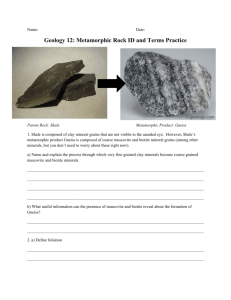
![[[1]] Camp Thibet [Tibet] frontier Sikkim Himal Sept[ember] 30/ [18]49](http://s3.studylib.net/store/data/007477943_1-22e12d1840789f6a2bf4212df464a714-300x300.png)
